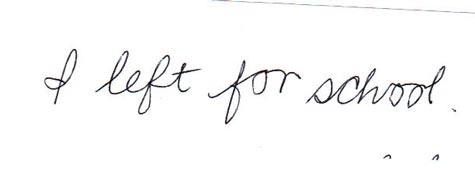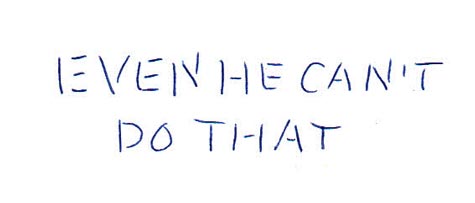
One handwritten warning flag that’s easily spotted is the Felon’s Claw. This backward-hooking stroke can appear in script or print writing. It’s unconsciously scribed by folks who feel guilty including, they say, three-quarters of those incarcerated for felony. (On the bright side, maybe we should feel reassured that so many felons retain a conscience.)
Unless you’re corresponding with No. 231749, however, you might first notice it in the writing of family, friends, colleagues—or your babysitter. If so, good catch because it often appears in the writing of those who feel they have something to hide, like the “good” kid who isn’t so good anymore. Perhaps she cheats on exams, is experimenting with drugs, or is a convincing liar—honestly, she has no idea what happened to all your vodka.
The Felon’s Claw can also appear in the writing of someone who grew up being made to feel guilty and who subconsciously believes he should continue getting punished. Even silent victims of abuse can unwittingly express feelings of guilt and shame via a Claw. If you see the Claw in the writing of someone you know or suspect has been abused, in whatever way at whatever time, it suggests the abuse remains an active burden.
The Felon’s Claw can also appear from the hand of those responding more actively to guilt. You know that guy who seems so nice? However genial he appears, if he writes with the Claw, do your best to stay clear of him. A Claw can reveal a desire to strike back in a way that feeds the writer’s entrenched sense of guilt. It’s considered a hallmark of vindictive types, backstabbers. Whether he’s known for making cutting remarks or for undermining a rival, the risk for trouble is visible when his writing displays a Felon’s Claw.
Next time you see gang graffiti, note how many tags bear a backhanded hook.

While the form is aberrant in adults, young children sometimes draw ovals this way before they are trained to write properly. This begs several questions: First, was the Palmer Method—the handwriting style taught in most schools during the last fifty years—designed to promote legibility, or to avert disaster? And if we no longer teach handwriting, will we be missing a chance to train youngsters away from future thievery, vengeful behavior and deception?

Despite the wealth of information handwriting offers, few writers seem to incorporate it into their stories. Mysteries featuring graphology are even rarer. In fact, I know of only one writer who features it, and she is a graphologist herself. Sheila Lowe, who wrote The Complete Idiot’s Guide to Handwriting Analysis, also writes a series whose main character, Claudia Rose, is a graphologist.
What a shame for her that fan “mail” is now mostly virtual.
See all of Kate Lincoln’s posts for Criminal Element.

Cool post….just checked all my note pads near my phones… I may be borderline with the “Felon’s Claw”, but what working mother who raised 2 now adult kids has lived her whole life with no guilt?!?!?
Loved this article. Thank you for posting.
Huh. I seem to remember I used the Felon’s Claw back in college, but now I don’t, and I don’t remember when I stopped doing that. I’ll have to go back through my old diaries and see if I can figure out when it faded away.
My best friend in high school always did the felons law. I remember wondering abt it. Well, back in late 1990’s, he shot his roommate and took out a kidney and lung portion. He got on the stand and lied, he got off. After he told me it was all a lie, I remembered the felons law and quickly dumped him as a friend (we live in different states). Then in 2002 he died a natural death. I never knew who the roommate was, but I hope he is ok.
Unon
what does it mean when someone prints letters in a word–some capitals and some small letters like this–ChaRLes19
I’ve been told it means they don’t want to be seen as in they don’t want to be figured out.
Handwriting & horoscopes, a bunch of hogwash…